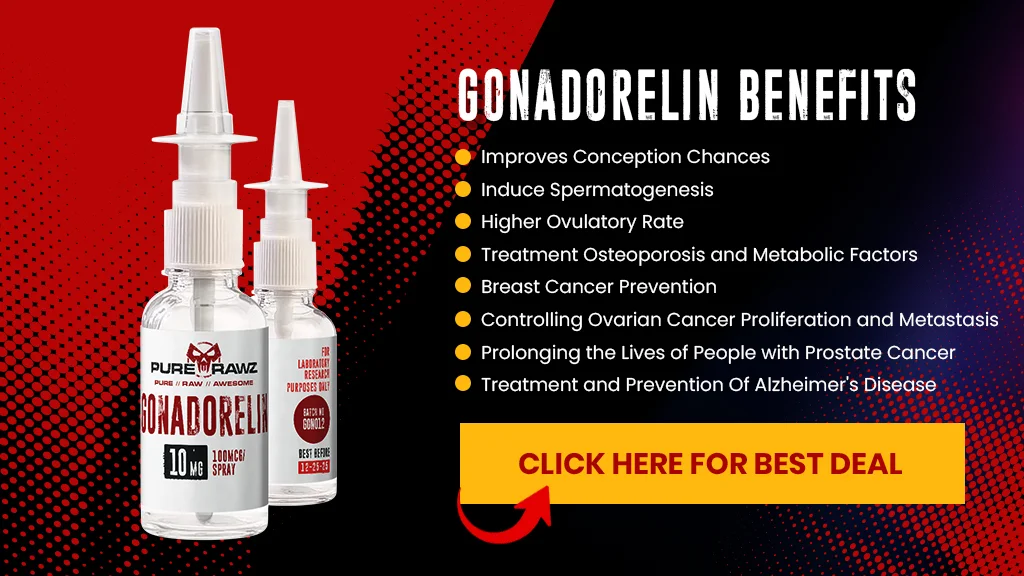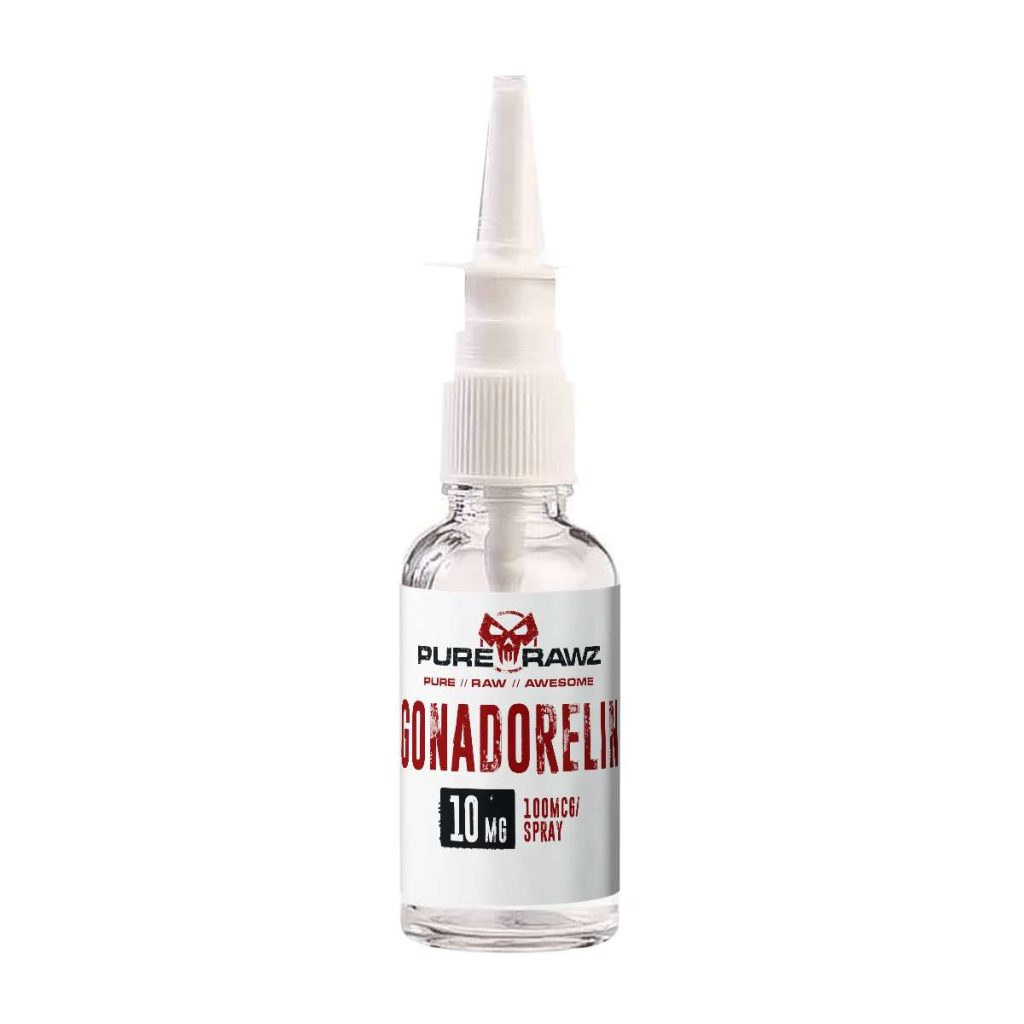Hormone-related infertility concerns may cause you to lose hope of ever becoming a parent. Infertility is a devastating problem for many couples, and it’s commonly caused by hormonal imbalances. The novel spray form of Gonadorelin, which has been shown to have the same transforming effects as the pill, maybe the answer you’ve been looking for all along. Those who have longed for a family can now have hope, thanks to this innovative breakthrough that provides a quick, accurate, and effective method to increase the secretion of vital hormones. Put an end to your never-ending process to have a family, and instead look forward to the bright future that may lie ahead, thanks to Gonadorelin.
Introduction
Gonadorelin is a synthetic peptide composed of ten amino acids with a molecular weight of 1182.3 g/mol. Structurally, it closely resembles the gonadotropin-releasing hormone (GnRH), a pivotal hormone responsible for stimulating the anterior pituitary gland to release luteinizing hormone (LH) and follicle-stimulating hormone (FSH), which are vital in regulating reproductive functions. [R]In the medical field, Gonadorelin serves multifaceted roles. It is utilized to assess the functioning of the pituitary gland and hypothalamus, shedding light on their performance. Furthermore, Gonadorelin is an invaluable tool in treating female infertility, as it triggers the secretion of GnRH, thereby facilitating the production of mature eggs from the ovaries. This renders Gonadorelin indispensable in aiding women with fertility issues.[R]
Product Information:
Gonadorelin, in its innovative spray form, is poised to revolutionize the way we harness the power of this vital hormone regulator. Unlike traditional capsules, the spray form offers several advantages. It allows for faster absorption through the nasal mucosa, ensuring a quicker onset of action. This means individuals can experience the benefits of gonadorelin more rapidly, making it an efficient choice for hormonal balance.
Furthermore, the spray form offers precise dosing, ensuring patients receive the right amount of this hormone regulator, which is especially important for those dealing with specific health conditions. The ease of use and enhanced effectiveness of the spray form make Gonadorelin an exciting development in hormone therapy, promising improved outcomes and convenience for patients.
Incorporating Gonadorelin’s potential into clinical practice can bring hope to those seeking hormone regulation and improved bone health, while also contributing to a broader understanding of its therapeutic capabilities.
How Does It Work?
Image source: https://pubchem.ncbi.nlm.nih.gov/compound/9811102#section=Structures
Gonadorelin plays a pivotal role in orchestrating the synthesis of two crucial reproductive hormones: follicle-stimulating hormone (FSH) and luteinizing hormone (LH). Its intricate mechanism revolves around selectively stimulating specific signaling pathways based on the frequency of gonadotropin-releasing hormone (GnRH) pulses.[R]
The frequency at which Gonadorelin is released directly influences the signaling it conveys to gonadotropic cells. This modulation of signal frequency is essential for the Gonadorelin Receptor (GnRHR) to respond in distinct ways, ultimately affecting the synthesis of LH and FSH.
At its core, Gonadorelin operates by regulating the release of luteinizing hormone (LH) and follicle-stimulating hormone (FSH) through the modulation of Gonadotropin Releasing Hormone (GnRH), which is important in fertility.
This intricate hormonal mechanism is orchestrated within the neural command center of the brain, precisely the hypothalamus and preoptic area of the forebrain, where GnRH neurons are located. During the estrus phase, elevated levels of estradiol serve as a pivotal catalyst for the release of GnRH, setting in motion a cascading sequence of events. This sequence, akin to a meticulously timed symphony, results in the synthesis and secretion of LH, ultimately culminating in the LH surge that triggers the process of ovulation. Notably, estradiol and progesterone exert significant influence over the neurons responsible for GnRH and LH release. Moreover, the expression of LH receptor mRNA in granulosa cells becomes particularly pertinent when the dominant follicle reaches a specific size, ensuring a harmonious and regulated ovulatory response to GnRH treatments at various stages of the estrous cycle. A thorough comprehension of this chemical orchestration sheds light on the intricate and fascinating mechanisms governing the world of reproduction. [R]
Gonadorelin – Benefits:
Gonadorelin has undergone extensive clinical research and randomized clinical trials, exploring its potential health benefits, especially in the context of reproduction. We’ve compiled some of the potential benefits below:

1. Improves Conception Chances
Gonadotrophin therapy, employing a combination of HCG and rFSH injections, opens doors to remarkable benefits for men facing gonadotrophin deficiency. Its primary advantage lies in its effectiveness, as it successfully induces testis growth, sparks spermatogenesis, and ultimately restores fertility in those who might have otherwise faced reproductive challenges. For individuals grappling with subnormal sperm counts, the availability of assisted reproductive techniques further enhances the prospect of achieving conception, offering newfound hope for parenthood.
In addition to its efficacy, gonadotrophin therapy also boasts a well-tolerated profile. Its safety and ability to bring about significant improvements in reproductive function make it a promising option for individuals facing gonadotrophin deficiency. With the guidance of healthcare professionals and the commitment of patients to self-administer injections and adhere to monitoring, gonadotrophin therapy’s benefits can be harnessed with confidence.
Moreover, this therapy aligns with individualized care, as it offers a tailored approach to address factors such as baseline testicular volume, history of cryptorchidism, sexual maturation, and prior testosterone replacement therapy. These considerations play a crucial role in predicting treatment success, ensuring that those who embark on this journey have a personalized path to enhanced fertility and the potential to embrace the joys of parenthood.[R]
2. Induce Spermatogenesis
When it comes to male infertility caused by pituitary insufficiency, gonadotropins are an exceptionally effective treatment. Hormones that were previously derived from urine have experienced significant progress in the laboratory, leading to the development of recombinant forms such as human chorionic gonadotropin (rec-hCG), FSH (rec-hFSH), and LH (rec-hLH) and highly purified urinary gonadotropins.
In a study, the therapeutic effect for male infertility started with the administration of hCG alone. If no sperm is detected after several months of treatment but adequate serum testosterone levels are achieved, FSH is introduced. Gonadotropin treatment involves subcutaneous self-administered injections, typically ranging from 75-150 IU of FSH or human menopausal gonadotropin (hMG), given two to three times weekly. Additionally, 1,500-2,500 IU of hCG is administered twice weekly. This treatment course can extend from 6 to 24 months or more, persisting until sperm appears in the ejaculate and/or pregnancy is achieved. What’s particularly remarkable is that gonadotropins have demonstrated the ability to induce spermatogenesis in approximately 80% of treated men, and in some instances, a combination of hCG with hFSH, urine-hFSH, or hMG has pushed this success rate to 94%. Moreover, while the timeline for sperm appearance may vary, most studies report an average of seven months, with an average of 28 months to attain pregnancy. In addition, the side effects of gonadotropins are generally minimal, and with precise dose adjustments to optimize testosterone levels, concerns like gynecomastia, acne, flu-like symptoms, and weight gain can be managed.[R]
3. Higher Ovulatory Rate
In a study, cows received gonadorelin diacetate tetrahydrate, and their LH levels were monitored. The study revealed that the “C” formulation of gonadotrophin induced a greater LH release and resulted in a higher ovulatory rate, but this effect was not uniform across different cattle populations. These findings contribute to our understanding of gonadotrophin’s influence on reproductive processes in cattle, [R]
4. Treatment Osteoporosis and Metabolic Factors in Hypogonadotropic Hypogonadism
Aging is frequently linked to osteoporosis, a condition noted for its compromised bone strength and increased susceptibility to fractures. A prevalence analysis, nonetheless, revealed that young males are particularly susceptible to hypogonadotropic hypogonadism (HH), a physiological state characterized by inadequate production of gonadotropin hormones. To evaluate the effects of gonadorelin treatment on metabolic parameters and bone health, the study enrolled twenty-two young male patients with HH and twenty healthy controls.
The findings revealed that osteoporosis was significantly more prevalent in HH patients, affecting 45% of them, compared to just 10.00% in the control group. HH patients exhibited lower bone mineral density (BMD) in various areas, including the lumbar spine, femoral neck, and total hip. Additionally, they had higher levels of fasting insulin, HOMA-IR (a marker of insulin resistance), and SHBG (sex hormone-binding globulin) when compared to the healthy controls.
After 6 months of pulsatile gonadorelin treatment, the HH patients experienced improvements in BMD, body mass index (BMI), and various metabolic parameters, including total cholesterol, fasting insulin, HOMA-IR, and SHBG. This suggests that gonadotrophin treatment can positively impact bone health and metabolic factors in individuals with HH, offering potential hope for those facing the challenges of osteoporosis at a young age.[R]
5. Breast Cancer Prevention
Women, especially those at high risk, worry about breast cancer. Traditional prevention methods like selective estrogen receptor modulators and aromatase inhibitors work but have side effects that deter their use. A novel approach to reduce estrogen production by suppressing androgen precursors with long-acting gonadotropin-releasing hormone analogs is emerging.
This novel approach targets elderly postmenopausal women at high risk of breast cancer who have high testosterone levels, a sign of ovarian hyperandrogenemia. High testosterone levels have long been linked to breast cancer. Ovarian interstitial cell hyperplasia, common in breast cancer patients, causes the postmenopausal ovary to produce too much androgen. The new approach reduces estrogen formation without completely inhibiting estrogen synthesis by targeting this source of androgen excess in women with ovarian stromal hyperplasia.
Postmenopausal women can safely prevent breast cancer with long-acting gonadotropin-releasing hormone analogs, according to research. This alternative approach may revolutionize breast cancer prevention for high-risk women by being more effective and well-tolerated. This novel approach to breast cancer may become effective as more studies and clinical trials are conducted.[R]
6. Controlling Ovarian Cancer Proliferation and Metastasis
Ovarian cancer, a significant challenge in the field of women’s health, has been the focus of extensive research efforts. Gaining insight into the complexities of the hypothalamus-pituitary-gonadal (HPG) axis, which serves as the endocrine regulatory system responsible for governing the female reproductive cycle, provides valuable knowledge regarding a potential contributor to the development and progression of ovarian cancer—the gonadotropin-releasing hormone (GnRH).
Gonadotropin-releasing hormone (GnRH) assumes a prominent role in this discourse. In addition to its crucial role in the gonadotrophic cells of the pituitary gland, this protein is also expressed in several reproductive organs, such as the ovaries. Significantly, it manifests in tumors that originate from the ovary, hence further enhancing its importance in ovarian cancer. This systematic review aims to explore the several functions of GnRH in the context of ovarian cancer. The regulation of proliferation and metastasis is influenced by it, exerting its effects by both indirect means, via the hypothalamic-pituitary-gonadal (HPG) axis, and direct means, by interacting with the gonadotropin-releasing hormone (GnRH) receptors expressed on the surface of ovarian cancer cells. This thorough investigation provides a view into the complex network of interactions between GnRH and ovarian cancer, which has the potential to offer novel perspectives on the etiology, advancement, and therapeutic approaches for this tough condition.[R]
7. Prolonging the Lives of People with Prostate Cancer
The pivotal discovery of the late 20th century surrounding the local androgen synthesis within the prostate from DHEA and DHEA-S paved the way for a transformative approach in the management of prostate cancer. Gonadorelin in conjunction with pure antiandrogens like flutamide, bicalutamide, or nilutamide, forming what is known as combined androgen blockade (CAB).
Through well-structured prospective studies, CAB demonstrated extension of the lives of prostate cancer patients, particularly those with advanced stages, but it also showcased its increased effectiveness when applied to localized prostate cancer. This approach could potentially achieve a cure rate of at least 90%, marking a significant advancement in the fight against this disease. Furthermore, the enduring benefits of androgen blockade in prostate cancer treatment have been underappreciated. By defying the misconception that resistance to treatment would develop, CAB offers hope and a cure, especially when administered immediately to patients who fail other treatments like radical prostatectomy, radiotherapy, or brachytherapy. With early diagnosis, often through screening, and the efficient CAB approach, prostate cancer mortality can become a rare occurrence. This highlights a substantial victory in the battle against prostate cancer, ensuring that more patients can benefit from prolonged and improved quality of life, with Gonadorelin playing a central role in this innovative therapeutic approach.[R]
8. Treatment and Prevention Of Alzheimer’s Disease (AD)
In the complex web of neurological function, the hypothalamic-pituitary-gonadal (HPG) hormones, including luteinizing hormone (LH), gonadotropin-releasing hormone (GnRH), and activins, are emerging as unexpected regulators. These hormones, traditionally associated with the reproductive system, possess neuronal receptors that are strategically located throughout the limbic system. Like their counterparts in reproductive tissues, the expression of these receptors is subject to hormonal feedback loops. It’s this intricate interplay that underscores their pivotal role in shaping brain structure and functions.
Dysregulation of the HPG axis during events like menopause and andropause, leading to elevated LH, GnRH, and activin signaling but reduced sex steroid signaling, has the potential to influence the structure and function of neuronal cells. Of these hormones, LH has garnered the most evidence as a promoter of neurodegenerative changes. It can cross the blood-brain barrier and is densely concentrated in the hippocampus, a brain region particularly vulnerable to Alzheimer’s disease (AD). Additionally, LH has been found to elevate in both the serum and pyramidal neurons of AD subjects. LH’s connection to AD extends further, as it promotes the amyloidogenic processing of the amyloid-beta precursor protein in vitro. The intriguing connection between LH and neurodegeneration has prompted research into treatments, such as the use of GnRH analogs, which holds the potential to provide new insights into the gonadotropin-AD link. This research opens doors to understanding how hormonal dynamics may play a significant role in neurological conditions like AD and offers hope for new avenues in treatment and prevention.[R]
What is Gonadotropin Releasing Hormone Adenoma ?
Gonadotropin-releasing hormone adenoma is a type of abnormal growth or tumor that can develop in the pituitary gland, a small gland in the brain. This tumor causes the gland to produce too much of a hormone called gonadotropin-releasing hormone (GnRH). Normally, GnRH helps regulate hormones related to reproduction.
When there’s an adenoma, the excess GnRH can disrupt the balance of hormones in the body, leading to issues like irregular periods in women or hormone imbalances in men. Treatment options can include medication or surgery to address this problem.
How Gonadorelin Aid in Testicular Shrinkage
Gonadorelin is a GnRH agonist employed in men undergoing testosterone replacement therapy to help prevent testicular shrinkage and infertility. By stimulating the production of hormones that control testicular function, Gonadorelin can help maintain the size and function of the testes during testosterone replacement therapy.
Side Effects:
Gonadorelin is a medication utilized to stimulate the release of specific hormones in the body, particularly gonadotropin-releasing hormone (GnRH). It is often prescribed to address conditions like infertility, delayed puberty, and certain hormonal disorders. GnRH antagonists are also used in clinical settings for specific purposes.
Gonadorelin is available in various forms, with nasal sprays being one option. It’s important to highlight that the side effects associated with gonadorelin and other gonadotropins are generally mild. By carefully adjusting the dosage to optimize testosterone levels, potential issues such as gynecomastia (breast enlargement in males), acne, flu-like symptoms, and weight gain can be effectively managed. These medications are commonly employed to address hormonal imbalances and reproductive concerns, typically under the guidance of healthcare professionals who can customize treatment plans to minimize side effects while achieving therapeutic objectives.
Is Gonadorelin legal?
Gonadorelin is a synthetic peptide used clinically in the medical field to diagnose and treat hormonal disorders, including reproductive system-related issues. Its applications include assessing pituitary and gonadal function in hypogonadism cases, inducing ovulation to enhance fertility in women, delaying premature puberty in children, and suppressing testosterone production in advanced prostate cancer patients. Additionally, it aids in hormonal assays for diagnosing endocrine disorders. Legalities surrounding Gonadorelin’s use may vary by country and its regulations, typically requiring prescription and healthcare professional supervision to ensure safe and appropriate treatment. Adherence to local laws and regulations concerning its purchase, possession, and use is essential to avoid legal issues and health risks.
Suggested Dose
The Gonadorelin spray dosage is not fixed and can vary depending on the specific medical condition it is prescribed for, as well as factors like the patient’s age and weight. Gonadorelin is a medication commonly used in the treatment of hormonal disorders, including conditions such as delayed puberty and infertility.
It is crucial to emphasize that the precise dosage and administration guidelines must be determined by a qualified healthcare provider, such as a doctor or an endocrinologist. This determination is based on the patient’s unique medical needs and the specific condition under treatment. The method of administering Gonadorelin, whether as a nasal spray or by injection, can also differ depending on the situation.
For example, in the case of individuals diagnosed with hypogonadotropic hypogonadism, a total daily dosage of 90 µg (micrograms) of spray is prescribed. This amount is divided into 15 µg applied to each nostril three times a day. Therefore, the Purerawz 100mcg variant of Gonadorelin may serve as a suitable starting point in line with this recommendation. [R]
Where to buy Gonadorelin Online
To buy Gonadorelin nasal spray, PureRawz emerges as the ideal destination. As a leading supplier of research chemicals, both online stores consistently offer reference materials alongside each product or research chemical in their inventory.

Conclusion:
Gonadotropin Releasing Hormone Agonists, including gonadotropin-releasing hormone agonists, play a pivotal role in the regulation of reproductive functions. Gonadotropin Releasing Hormone Agonists’ applications in the medical field are diverse, from assessing pituitary and hypothalamus functionality to aiding in female infertility treatment. With the introduction of innovative spray forms, Gonadotropin gonadotropin-releasing hormone Agonists have become more accessible and efficient, allowing for rapid absorption and precise dosing. This advancement promises improved outcomes and convenience for patients seeking hormonal balance.
Gonadotropin Releasing Hormone Agonists’ mechanism of action is a marvel of precision, controlling the synthesis of crucial hormones like luteinizing hormone (LH) and follicle-stimulating hormone (FSH). The modulation of its release frequency directly influences the hormonal signaling pathways, offering insight into the core of reproductive hormone regulation. This intricate control mechanism underscores its significance in reproductive health. Furthermore, extensive research highlights gonadotropin-releasing hormone Agonists’ diverse health benefits. From improving conception chances in men facing gonadotrophin deficiency to inducing spermatogenesis, addressing osteoporosis, and even potential applications in breast cancer prevention, gonadotropin-releasing hormone Agonists demonstrate their versatility. They also play a role in controlling ovarian cancer proliferation and metastasis and show promise in extending the lives of people with prostate cancer. Additionally, their connection to estrogen receptors opens doors to new treatment and prevention avenues, emphasizing the far-reaching impact of this remarkable hormone regulator in preventing testicular shrinkage.
In summary, gonadotropin-releasing hormone Agonists’ multifaceted potential extends to various aspects of health, promising hope and improved quality of life for many individuals. Their continued exploration and application in the medical field hold the potential to transform the landscape of healthcare, offering new solutions to age-old challenges.


